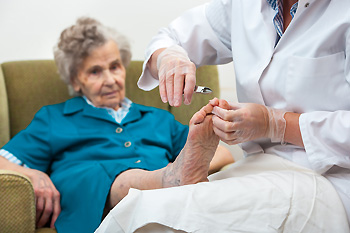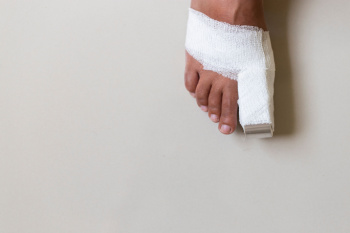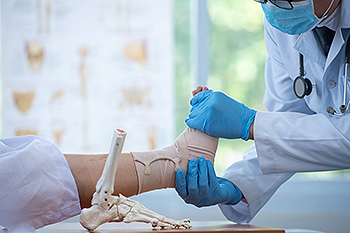Items filtered by date: July 2025
Corns on the Feet Are Small Bumps That Can Cause Big Discomfort

Corns are thickened areas of skin that develop on the feet due to repeated pressure or friction, often from tight shoes, high heels, or abnormal gait. They commonly form on the top and sides of toes or the soles of the feet. Corns may appear as hard, raised bumps surrounded by inflamed skin. They can feel rough to the touch and may cause tenderness or a burning sensation, especially when walking or wearing shoes. While over-the-counter remedies exist, improper removal can lead to infection or worsening symptoms. A podiatrist can safely remove corns, assess for underlying causes like misaligned toes or poor footwear, and recommend treatments such as custom orthotics, padding, or changes in footwear to prevent recurrence. If corns are interfering with your comfort or mobility, it is suggested that you make an appointment with a podiatrist.
If you have any concerns regarding your feet and ankles, contact one of our podiatrists of The Foot Specialists. Our doctors will treat your foot and ankle needs.
Corns: What Are They? and How Do You Get Rid of Them?
Corns can be described as areas of the skin that have thickened to the point of becoming painful or irritating. They are often layers and layers of the skin that have become dry and rough, and are normally smaller than calluses.
Ways to Prevent Corns
There are many ways to get rid of painful corns such as wearing:
- Well-fitting socks
- Comfortable shoes that are not tight around your foot
- Shoes that offer support
Treating Corns
Treatment of corns involves removing the dead skin that has built up in the specific area of the foot. Consult with Our doctors to determine the best treatment option for your case of corns.
If you have any questions, please feel free to contact our offices located in Waltham and Milford, MA . We offer the newest diagnostic and treatment technologies for all your foot care needs.
Common Problems That Affect Aging Feet

As we grow older, our feet experience natural changes that can lead to discomfort and mobility issues. The skin becomes thinner and drier, fat pads on the soles wear down, and circulation may slow. These shifts can make walking or standing more difficult and increase the risk of injury. Common problems include bunions, hammertoes, arthritis, and thickened or brittle toenails. Many seniors also develop calluses, corns, or changes in foot shape that make shoes less comfortable. Nerve sensitivity may decline, making it harder to notice pain or injury, especially in those with diabetes or vascular conditions. Staying active, wearing supportive footwear, and inspecting the feet regularly can help reduce the impact of these issues. Foot discomfort should never be seen as an acceptable part of aging. If you notice ongoing pain, numbness, or changes in how your feet feel or function, it is suggested you consult a podiatrist for evaluation and personalized care.
If you need your feet checked, contact one of our podiatrists of The Foot Specialists. Our doctors will attend to all of your foot and ankle needs and provide you with quality treatment.
Geriatrics and Podiatry
When people age, some common issues that may occur are bone density loss, dry skin, poor circulation, and rough brittle nails. These issues may also affect your foot health if the necessary steps are not taken to alleviate the problems.
It is important to take care of your feet because feet that are injured or diseased can affect your overall health. Having painful feet hinders your ability to do daily activities or may decrease your willingness to do the things that you need to do.
Visiting Your Geriatrician
As we age, health problems become more likely, so it is essential to visit your doctor for check-ups to ensure that you are doing the best you can to take care of your health. It is recommended to check your feet frequently for any possible cuts, bruises, swelling, corns or any other irregularities.
Taking Care of Elderly Feet
Cracked or dry feet can be treated by applying moisturizer often. It is also important not to wear old socks because the older the sock is, the higher the possibility there will be that there is bacteria there. Wear fresh socks and make sure they fit properly.
Proper foot health means that you can have a more active lifestyle and you will not be bogged down by pain. Foot health also leads to good circulation, which is paramount for overall health.
If you have any questions, please feel free to contact our offices located in Waltham and Milford, MA . We offer the newest diagnostic and treatment technologies for all your foot care needs.
Heel Pain in the Morning?
Treatment for a Fractured Toe

A broken toe occurs when one of the small bones in the toe sustains a fracture, typically due to trauma or repetitive stress. Symptoms of a fractured toe include pain, swelling, bruising, or redness, along with difficulty bearing weight or moving the toe. A visibly deformed or angled toe can suggest a more severe break. Diagnosis usually involves a physical exam and imaging, such as an X-ray, to confirm the fracture and assess alignment. In some cases, more detailed imaging like an MRI scan may be required to detect stress fractures or ligament injuries. Treatment depends on the type and severity of the break. Supportive measures include buddy taping, splinting, or the use of a hard-soled shoe or walking boot to stabilize the toe during healing. Surgery may be necessary for displaced fractures or joint damage, and can involve pins or wires to maintain alignment. If you injure a toe or think it may be broken, it is suggested that you promptly schedule an appointment with a podiatrist for a diagnosis and appropriate treatment.
Broken toes may cause a lot of pain and should be treated as soon as possible. If you have any concerns about your feet, contact one of our podiatrists from The Foot Specialists. Our doctors will treat your foot and ankle needs.
What Is a Broken Toe?
A broken toe occurs when one or more of the toe bones of the foot are broken after an injury. Injuries such as stubbing your toe or dropping a heavy object on it may cause a toe fracture.
Symptoms of a Broken Toe
- Swelling
- Pain (with/without wearing shoes)
- Stiffness
- Nail Injury
Although the injured toe should be monitored daily, it is especially important to have a podiatrist look at your toe if you have severe symptoms. Some of these symptoms include worsening or new pain that is not relieved with medication, sores, redness, or open wounds near the toe.
If you have any questions please feel free to contact our offices located in Waltham and Milford, MA . We offer the newest diagnostic tools and technology to treat your foot and ankle needs.
Sever's Disease and the Role of a Podiatrist

Sever's disease, also called calcaneal apophysitis, is a common cause of heel pain in growing children, especially those who are active in sports. It occurs when the growth plate in the heel becomes inflamed due to repetitive stress or overuse. Causes include running, jumping, and improper footwear. Symptoms include heel pain during activity, limping, or tenderness when the heel is squeezed. Risk factors include rapid growth spurts, high-impact sports, and flat or high-arched feet. A podiatrist can diagnose the condition through examination and recommend treatments such as rest, stretching, and shoe modifications. If your active child complains of heel pain, it is suggested that you schedule a visit with a podiatrist who can provide an accurate diagnosis and treatment.
Sever's disease often occurs in children and teens. If your child is experiencing foot or ankle pain, see one of our podiatrists from The Foot Specialists. Our doctors can treat your child’s foot and ankle needs.
Sever’s Disease
Sever’s disease is also known as calcaneal apophysitis, which is a medical condition that causes heel pain I none or both feet. The disease is known to affect children between the ages of 8 and 14.
Sever’s disease occurs when part of the child’s heel known as the growth plate (calcaneal epiphysis) is attached to the Achilles tendon. This area can suffer injury when the muscles and tendons of the growing foot do not keep pace with bone growth. Therefore, the constant pain which one experiences at the back of the heel will make the child unable to put any weight on the heel. The child is then forced to walk on their toes.
Symptoms
Acute pain – Pain associated with Sever’s disease is usually felt in the heel when the child engages in physical activity such as walking, jumping and or running.
Highly active – Children who are very active are among the most susceptible in experiencing Sever’s disease, because of the stress and tension placed on their feet.
If you have any questions, please feel free to contact our offices located in Waltham and Milford, MA . We offer the newest diagnostic and treatment technologies for all your foot care needs.
Current Treatment Methods for Ankle Fractures

Ankle fractures can range from minor cracks to severe breaks involving multiple bones. Treatment depends on the type and extent of the injury. For stable fractures where the bones remain in place, non-surgical care such as a cast, walking boot, or splint may be enough to allow proper healing. Elevation and limited weight-bearing are often part of early recovery. In cases where the bones are out of alignment or the joint is unstable, surgery may be required. This usually involves placing screws or plates to hold the bones in position as they heal. Targeted exercises are often recommended after the bone has healed to restore movement, strength, and balance. Healing time can vary depending on the injury and the treatment method. If you have suffered an ankle injury and are unsure of its severity, it is suggested that you visit a podiatrist for an evaluation and appropriate treatment plan.
Broken ankles need immediate treatment. If you are seeking treatment, contact one of our podiatrists from The Foot Specialists. Our doctors can provide the care you need to keep you pain-free and on your feet.
Broken Ankles
A broken ankle is experienced when a person fractures their tibia or fibula in the lower leg and ankle area. Both of these bones are attached at the bottom of the leg and combine to form what we know to be our ankle.
When a physician is referring to a break of the ankle, he or she is usually referring to a break in the area where the tibia and fibula are joined to create our ankle joint. Ankles are more prone to fractures because the ankle is an area that suffers a lot of pressure and stress. There are some obvious signs when a person experiences a fractured ankle, and the following symptoms may be present.
Symptoms of a Fractured Ankle
- Excessive pain when the area is touched or when any pressure is placed on the ankle
- Swelling around the area
- Bruising of the area
- Area appears to be deformed
If you suspect an ankle fracture, it is recommended to seek treatment as soon as possible. The sooner you have your podiatrist diagnose the fracture, the quicker you’ll be on the way towards recovery.
If you have any questions, please feel free to contact our offices located in Waltham and Milford, MA . We offer the newest diagnostic and treatment technologies for all your foot care needs.

